Part II : Types of Pen Hold and Managing Change
“Nicola, can you stay behind at the end of the lesson please,” said Mr Cowan my first-year secondary English teacher (it was before the term ‘Year 7’ existed).
I rolled my eyes…internally. I was usually only internally rebellious.
Believe it or not I was sometimes naughty at school. I was one of those students who managed to get away with things because I was generally cheerful and helpful.
So I assumed I was probably going to be gently reprimanded for some wrong-doing, but to my horror Mr Cowan announced, “I’ve noticed your pen hold is wrong and I've put you down to attend a group each week to correct it.”
I was mortified!
I’d always prided myself on having nice handwriting and was at that exciting stage where I was experimenting with developing my own cool style. I’d never even considered how I held my pen! How dare he! A wave of heat flooded my face and I found myself struggling to hold back tears of embarrassment and rage.
I attended one session. I was moody, sulky and stubbornly refused to engage. The internal rebel stepped out onto the stage and blinked in the spotlights.
Mr Cowan gave up and we moved on.
This is NOT how to manage or affect changing a pen hold.
Looking back years later, a teacher myself, I imagined Mr C had been on a course. He’d probably been told that the tripod grip was the one and only correct grip (he was misinformed) and had honourably set about fixing those of us whose pen holds were incorrect. I know he had the right intentions; he just went about it the wrong way.
And no, I’m not revealing my pen hold yet; it’s a cliff-hanger, you’ll have to wait til the end!
Before I outline key points to be aware of when supporting someone to change their grip, let’s look at types of pen hold. I’ll only cover some common ones so that I (hopefully) don’t lose your attention! Please bear in mind there are a range of variations.
Considering these will help make sense of why awkward holds develop, why there are benefits to modifying some holds and why others are absolutely fine to leave alone.
Firstly, let me remind you of the Better Handwritten goals I shared in Part I of this blog, 'Can and should pen hold be corrected?'

When thinking about a person and their handwriting:
we want them to feel good about it.
we want it to be legible (to themselves and to others)
we want it to be useful (different handwriting for different purposes)
For some people, pen hold impacts negatively on these goals because it:
is painful (the kind of pain that you get used to and grudgingly accept or avoid encountering whenever possible)
causes frustration (for example with smudging, when work is constantly spoiled and writing hand stained) which leads to stress
draws unwanted attention and comments about looking awkward or different (causing self-consciousness and anxiety)
constantly interrupts their view of what’s been written, which affects immediate review and reflection
affects outcomes (an inefficient grip blocks finger movements; this impacts on ability to write at speed, which in turn can impact on school work and exam performance)
So how does an individual’s pen hold evolve in the first place?
Put simply, there's a process to work through.
Pencils and pens are tools; from an early age we became aware of them by observing others using them. As with learning many early skills, we copied - based on our perception and ability at the time.
As young children that probably meant picking up a crayon in our little hand. We weren’t aware of the details of finger position and anyway, didn’t have fine motor control yet, so we adopted a fist grip.
A fist grip uses a whole arm movement... try miming it like I just did!
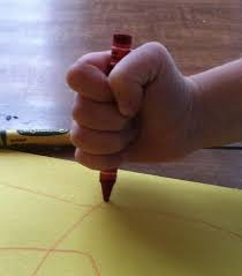
Around age 1 - 2
Gradually we discovered control was easier with our palm facing down and forefinger on top. We could control this from the elbow so it was a little less tiring.
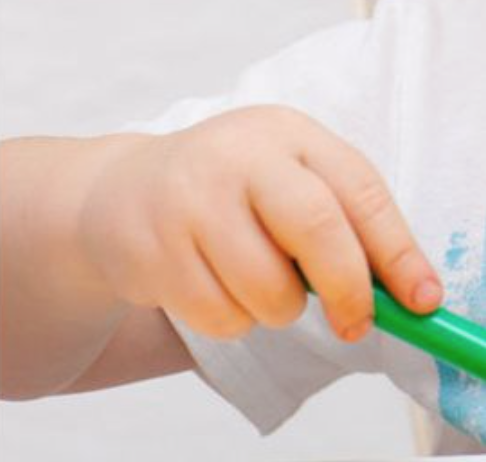
Around age 2 - 3
Over time, as muscles in the wrist and fingers strengthened, our hand began to turn to the side which meant we could control movement from the wrist and relax the arm. We had to adjust our fingers to balance the pencil.
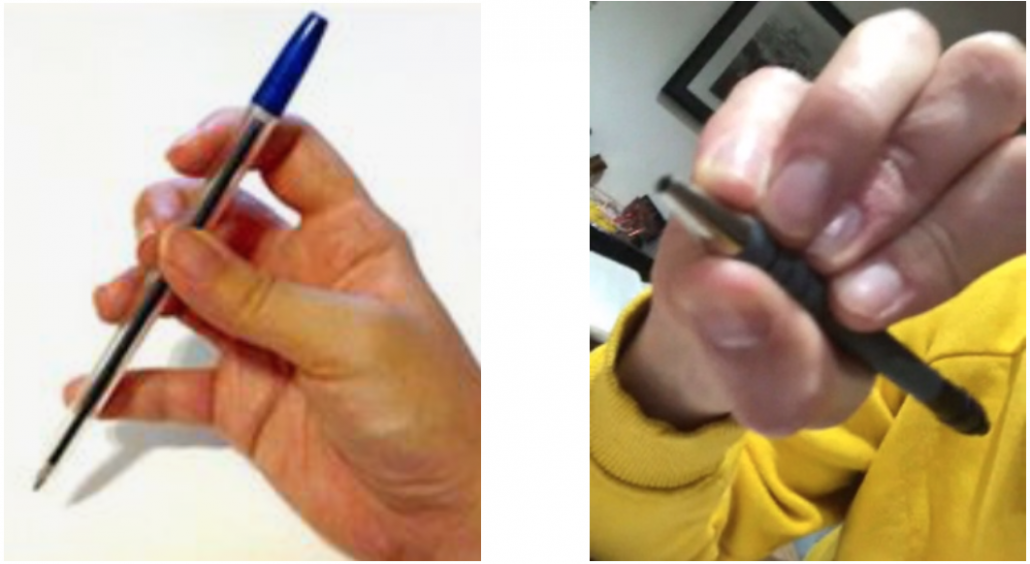
Age 4+
This seems to be the point where some creative positioning develops which unfortunately, if unnoticed and left unchecked, results in an awkward and often uncomfortable hold becoming automated.
What we want is an efficient grip that allows distal control (the ability to move the muscles of the fingers separately).
This brings us to the most effective pen holds: the dynamic tripod and quadrupod grips:
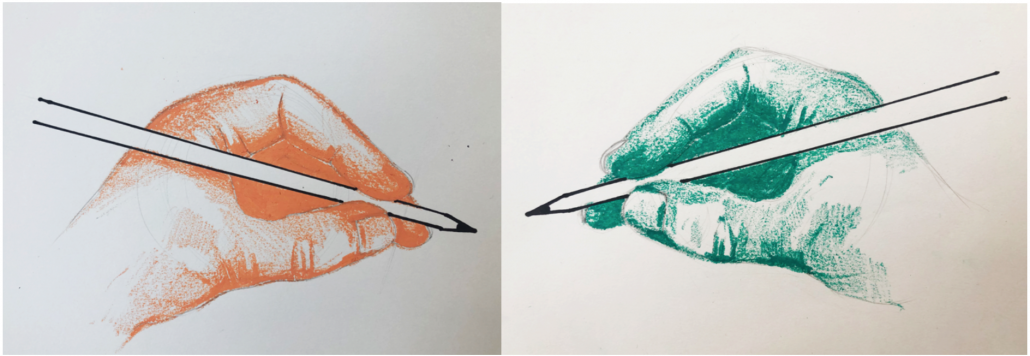
The dynamic tripod hold has 3 digits in contact with the pen (thumb, forefinger and middle finger)
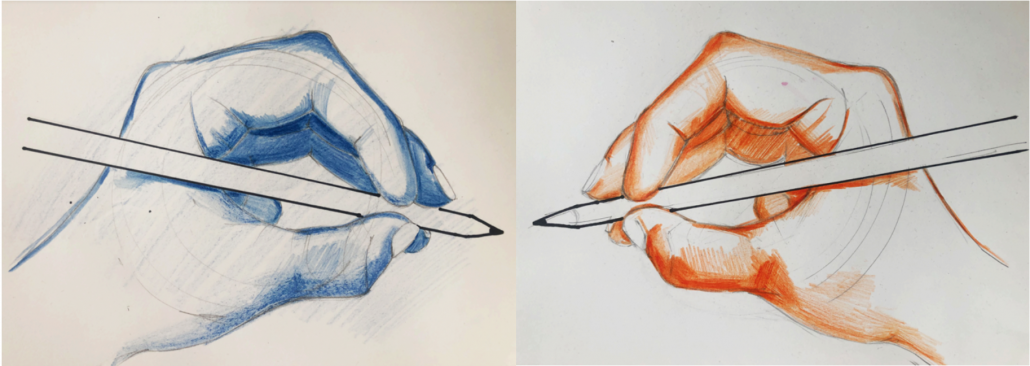
The dynamic quadrupod has 4 digits in contact (thumb, forefinger, middle finger and ring finger)
There are also 'lateral' versions of these grips where the thumb crosses the pencil, holding it in place but still allowing effective finger movements. These are generally fine too:
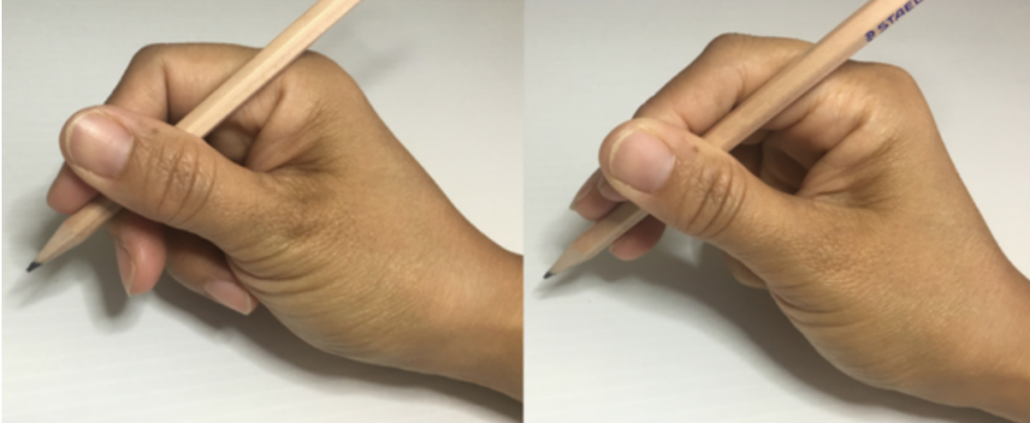
Lateral tripod and lateral quadrupod holds
Here are key points to give some careful thought to when reviewing a child's grip and managing change:
there is a developmental sequence to an individual’s pen hold evolving
not all children will naturally evolve an efficient grip
an efficient grip allows effective movement of the finger muscles; an inefficient grip restricts and blocks finger movement
adults may need to intervene and support change; it is crucial that teachers and parents understand how to help and work together
change is often met with emotional resistance; this is normal and to be expected. If this is not managed effectively however, the upset and damage caused may result in a negative association with writing and damaged self-esteem
inefficient pen holds should not be ignored and change shouldn’t be abandoned when resistance is met (but it must be managed compassionately and with confidence)
Mr Cowan gave up.
Amy gave up (Blog Part I).
Adam’s primary school teacher gave up (Blog Part I).
Not because they didn’t care, but because they were worried they would do more damage than good. They didn’t have the knowledge and understanding of the process of change or strategies to manage it effectively and confidently.
I hope this blog and Part I : Can and should pen hold be corrected? have been interesting and helpful to you. If you have questions or would welcome support around changing pen hold, sign up for one of the FREE Better Handwritten Starter Guides. You'll then have access to the community support page and can come and chat to me there :)
And no, I hadn’t forgotten... I’ll finish with The Big Reveal! I have a DYNAMIC QUADRUPOD hold :)
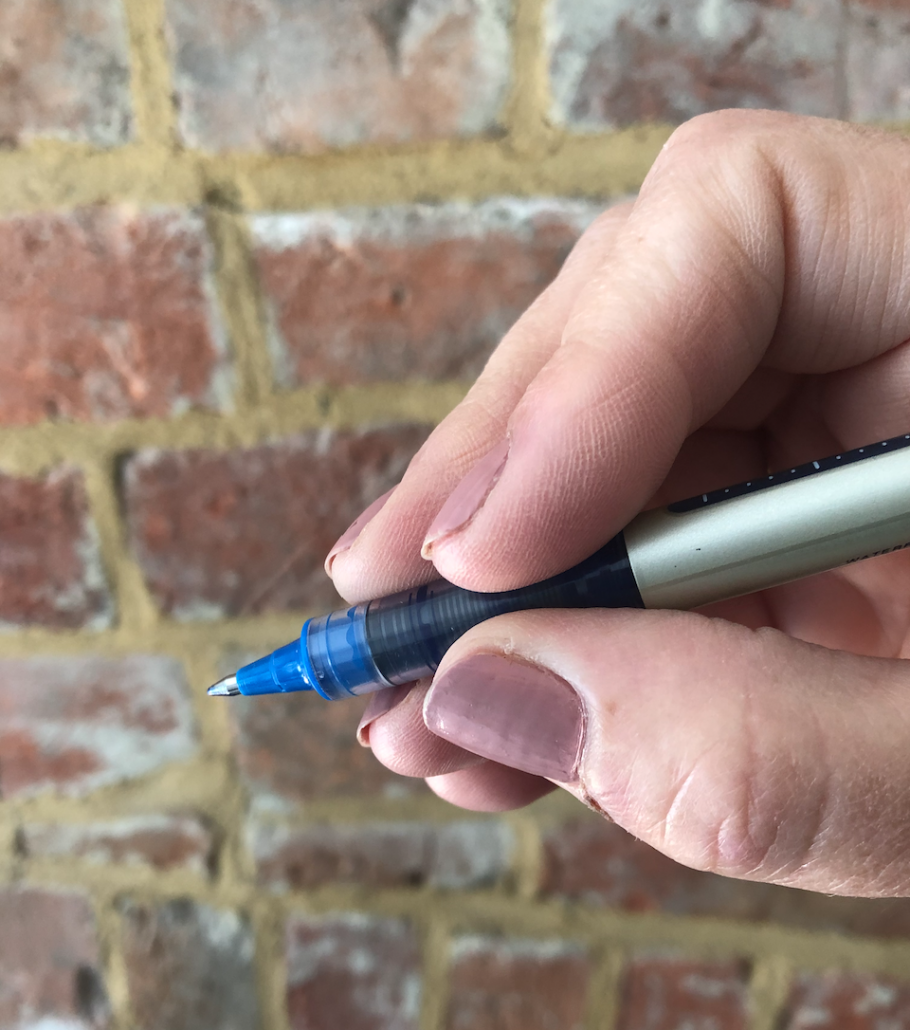
PS I actually have THREE pen holds and switch according to the task (or how I'm feeling)! The quadrupod is my long established, habitual grip.
I use a lateral quadrupod when recording demonstration videos, so my thumb doesn't block the view of pen meeting paper. Seeing the way letters and joins is the important thing for the viewer.
And I use a tripod grip when I feel like it. Now that's a choice... my choice and not made because someone else judges my other holds to be 'wrong' without knowing or explaining why.
